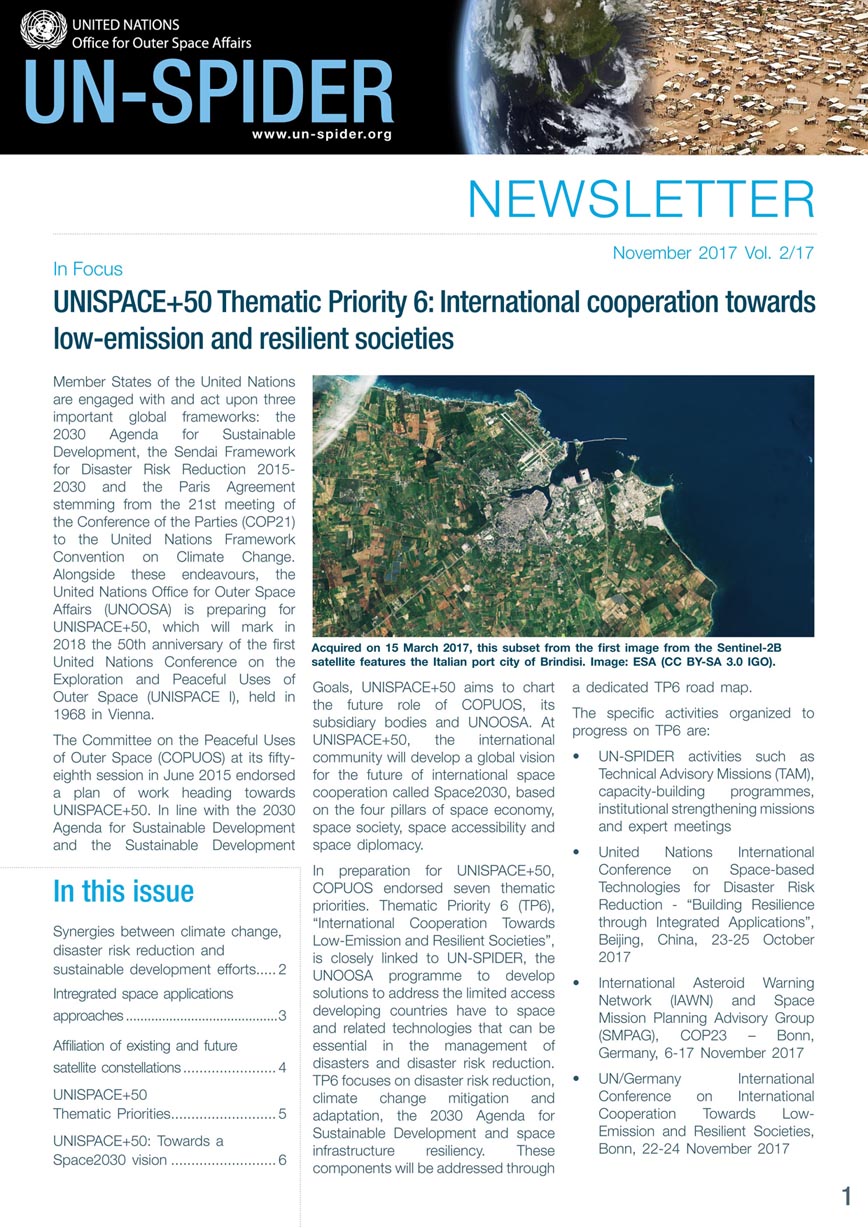Download the Newsletter (1.94 mb)
The Committee on the Peaceful Uses of Outer Space (COPUOS) at its fiftyeighth session in June 2015 endorsed a plan of work heading towards UNISPACE+50. In line with the 2030 Agenda for Sustainable Development and the Sustainable Development Goals, UNISPACE+50 aims to chart the future role of COPUOS, its subsidiary bodies and UNOOSA. At UNISPACE+50, the international community will develop a global vision for the future of international space cooperation called Space2030, based on the four pillars of space economy, space society, space accessibility and space diplomacy.
In preparation for UNISPACE+50, COPUOS endorsed seven thematic priorities. This newsletter addresses Thematic Priority 6 (TP6), “International Cooperation Towards Low-Emission and Resilient Societies”, which is closely linked to the work of the United´Nations Platform for Space-Based Information for Disaster Management and Emergency Reponse (UN-SPIDER), a programme of the United Nations Office for Outer Space Affairs (UNOOSA). TP6 focuses on disaster risk reduction, climate change mitigation and adaptation, the 2030 Agenda for Sustainable Development and space infrastructure resiliency.
After a brief introduction to UNISPACE+50, this newsletter addresses potential synergies in the use of space technologies climate change, disaster risk reduction and sustainable development efforts. Efforts in disaster risk reduction, as stipulated by the Sendai Framework, start with an improved understanding of risks related to natural hazards as the way to identify and implement measures to reduce such risks and to avoid their generation in decades to come. The fact that climate change is modifying the temporal and spatial characteristics of natural hazards creates opportunities for synergies between the two agendas, which are both an integral part of the Sustainable Development Goals (SDGs).
A further key component of TP6 are integrated space applications approaches and the interoperability of space-based and ground/in situ systems. With the use of satellite telecommunications in ground instruments deployed to monitor phenomena such as volcanic and seismic activity in remote areas, forecasters working in early warning systems have been able to compile more precise data on the spatial and temporal characteristics of natural hazards. This has improved the understanding of phenomena capable of triggering disasters, including volcanic eruptions, tsunamis, floods and, in selected cases, even earthquakes.
Thematic priority 6 also addresses the affiliation of existing and future satellite constellations for disaster risk reduction and climate change monitoring and mitigation. The long-term timeframe of the 2030 Agenda for Sustainable Development and the even longer timeframe of the Paris Agreement will demand innovative solutions from the space community. Constellations of satellites to be used to contribute to the monitoring of these global agendas will demand the provision of consistent, reliable and accessible data over long time periods.
| Attachment | Tamaño |
|---|---|
| UN-SPIDER Newsletter 2/17 - UNISPACE+50 Thematic Priority 6 (1.94 MB) | 1.94 MB |

